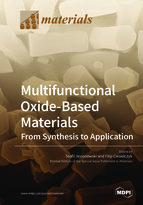Multifunctional Oxide-Based Materials: From Synthesis to Application
A special issue of Materials (ISSN 1996-1944).
Deadline for manuscript submissions: closed (15 May 2019) | Viewed by 43785
Special Issue Editors
Interests: biopolymers; synthesis, characterization, and applications of advanced functional materials; functional fillers and polymer composites; (bio)additives and eco-friendly fillers; biomineralization-inspired syntheses and extreme biomimetics; biocomposites and biomaterials; removal of wastewater pollutants via adsorption; photocatalysis or precipitation methods; pigment composites; enzyme immobilization
Special Issues, Collections and Topics in MDPI journals
Interests: multicomponent oxide systems; hybrid inorganic/organic materials; biomaterialsurface chemistry; inorganic pigments; catalysts; adsorption processes; environmental protection
Special Issue Information
Dear Colleagues,
The study and development of novel, oxide-based multifunctional materials with unique properties has become one of the most expanding fields in materials chemistry in recent years. The reason for this is that there are numerous inorganic/inorganic, as well as inorganic/organic, combinations that can be synthesized via different methods. The resulting mono-oxide and multicomponent systems or hybrids often possess exciting new properties for future materials, technological and environmental applications. This fact acts as a driving force for research and development of such systems. Even more importantly, these properties can be easily modified via the selection of hybrid components or via a typical functionalization process with the use of specific modifiers. Consequently, oxide-based hybrids have been widely applied in adsorption, catalysis (e.g., photocatalysis), polymer processing, optics, photoelectronics, electrochemistry, medicine, etc. This Special Issue focuses on recent advances in the synthesis, functionalization and application of oxide-based hybrids.
Proposed scope of this Special Issue is:
-
Synthesis of multifunctional oxide-based materials
-
Synthesis of hybrid inorganic/organic materials
-
Surface treatment (modification/grafting/immobilization)
-
Surface chemistry and functionality
-
Physicochemical characterization of oxide-based materials
-
Applications of oxide-based hybrids in electrochemistry, optics and biomedicine
-
Applications of oxide-based hybrids in environmental protection as catalysts (e.g., photocatalysts) or adsorbents of harmful inorganic and/or organic pollutants
Prof. Dr. Teofil Jesionowski
Dr. Filip Ciesielczyk
Guest Editors
Manuscript Submission Information
Manuscripts should be submitted online at www.mdpi.com by registering and logging in to this website. Once you are registered, click here to go to the submission form. Manuscripts can be submitted until the deadline. All submissions that pass pre-check are peer-reviewed. Accepted papers will be published continuously in the journal (as soon as accepted) and will be listed together on the special issue website. Research articles, review articles as well as short communications are invited. For planned papers, a title and short abstract (about 100 words) can be sent to the Editorial Office for announcement on this website.
Submitted manuscripts should not have been published previously, nor be under consideration for publication elsewhere (except conference proceedings papers). All manuscripts are thoroughly refereed through a single-blind peer-review process. A guide for authors and other relevant information for submission of manuscripts is available on the Instructions for Authors page. Materials is an international peer-reviewed open access semimonthly journal published by MDPI.
Please visit the Instructions for Authors page before submitting a manuscript. The Article Processing Charge (APC) for publication in this open access journal is 2600 CHF (Swiss Francs). Submitted papers should be well formatted and use good English. Authors may use MDPI's English editing service prior to publication or during author revisions.
Keywords
- inorganic oxides
- hybrid materials
- multicomponent systems
- catalysts (photocatalysts)
- synthesis routes
- surface chemistry
- modification
- adsorption
- immobilization
- characterization techniques
- environmental protection
- electrochemistry
- medical application
- catalysis (photocatalysis)








